This is the second installment of an ongoing series begun in Napoleon #2 promoting the Napoleonic Era's bicentennial.--RL
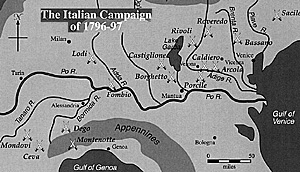 Following the treaty of Cherasco on 28 April, 1796, which removed Sardinia-Piedmont from the war, General Bonaparte's Army of Italy continued to pursue the Austrian Army up the Po River valley with the aim of destroying the First Coalition's primary army in Italy and seizing Milan. To accomplish this, Napoleon sent an advance guard under General Lannes to take the bridge at Piacenza and move against the Austrian rear.
Following the treaty of Cherasco on 28 April, 1796, which removed Sardinia-Piedmont from the war, General Bonaparte's Army of Italy continued to pursue the Austrian Army up the Po River valley with the aim of destroying the First Coalition's primary army in Italy and seizing Milan. To accomplish this, Napoleon sent an advance guard under General Lannes to take the bridge at Piacenza and move against the Austrian rear.
The Austrian commander, Beaulieu, had anticipated just such a move and attacked Lannes' force at Fombio on 8 May. Despite the Austrians' pre-emptive attack, Lannes led a charge that overwhelmed Beaulieu's Imperial troops, and the French Army of Italy extended its almost unbroken string of victories.
That night, Austrians who had been marching to the aid of their comrades at Fombio surprised the French outposts. During a sharp firefight in which the Austrians were thrown back, General Laharpe was mortally wounded, possibly by his own men. The French had lost the first of their heroes of Italy.
Napoleon's pursuit the next day resulted in the battle of Lodi [which was covered in Napoleon #2]. On 13 May the French occupied Milan; an Austrian detachment still held the citadel while Beaulieu's main force continued to retreat and Napoleon continued to pursue.
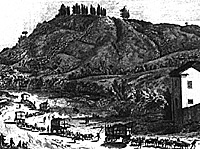 On 30 May, Bonaparte launched Sururier's Division at the center of Beaulieu's cordon defense at the town of Borghetto. The Austrian line was cut in two and retreated either to the north or into the fortress of Mantua. The French followed northward on the heels of their opponent's main army.
On 30 May, Bonaparte launched Sururier's Division at the center of Beaulieu's cordon defense at the town of Borghetto. The Austrian line was cut in two and retreated either to the north or into the fortress of Mantua. The French followed northward on the heels of their opponent's main army.
History as we know it was nearly undone on 1 June when Napoleon was almost captured by Neapolitan cavalry under Sebettendorf. This prompted him to form a cavalry troop as his personal guard called the Guides.
By 4 June, Beaulieu was driven north into the Tyrol, where he was soon relieved from command. Having placed Mantua under siege, the French went on a series of punitive raids to the south which cowed the various Italian states and reaped millions in loot needed to boost the French peoples' confidence in their government. As a consequence of these raids, Naples dropped out of the war taking its dangerous cavalry with it. Neapolitan troops would never again be held in such high esteem as they were in 1796.
The political situation in France at the beginning of May in 1796 was one of uncertainty. The government (the Directory) was financially broke and under pressure from without and within. On the same day as the battle of Lodi, Graccus Babeuf led a coup d'etat in Paris which was only stopped by luck and the plotters' incompetence. The government had only just survived the Royalist coup attempt of 13 October, 1795 and this attempt by the Left further destabilized the Directory.
Because of the political atmosphere of suspicion and mistrust, French military forces on the Rhine were divided between two commanders (Jourdan and Moreau) with neither in overall command. When the Directory informed Napoleon after Lodi that the same dual command structure would exist in Italy between himself and General Kellerman, Bonaparte fired back a stinging letter offering his resignation: "It is better to have a single mediocrity command all, than to divide the army between two superior commanders."
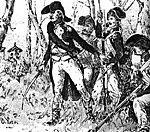 The French government could ill afford to dismiss one of its few popular heroes, so it quickly backed down and reinstated Napoleon as the overall commander of the Army of Italy.
The French government could ill afford to dismiss one of its few popular heroes, so it quickly backed down and reinstated Napoleon as the overall commander of the Army of Italy.
French strategy called for Napoleon to move north through the Alps to operate against the rear of Archduke Charles' Austrian Army, which was opposing Jourdan and Moreau. When the French failed to attack along the Rhine on 1 June as planned, Napoleon risked being caught in the Alps with enemy to his front and rear. Mantua had to be taken first to insure that Bonaparte's rear was secure.
Events would overtake the French, however, so that this grandiose plan would never be attempted. Control of the Alpine passes by the Austrians would put Napoleon in much peril in the following months. Over the next several issues we will continue to examine the 1796 Campaign where Napoleon experimented with his military theories, commanded his first major army, and built a reputation as a great captain of history.
Young General Bonaparte, not yet 27, did not accomplish this by himself. What follows is a brief summary of the men who played important roles during the campaign of 1796-97 in Italy.
Napoleon's Key Lieutenants
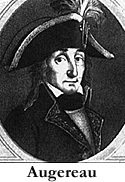 Augereau, Pierre Francois: This future Marshal was called a braggart, duelist, looter, and liar. He had served in the Prussian Army before deserting and it had given him a military air as well as an appreciation for discipline. He was well-groomed and impressed his men with a combination of swagger and authority. Age 39 in 1796, these were his glory days. It was at Castigilone in 1796 that Augereau's performance would later win him a Dukedom when Napoleon became Emperor.
Augereau, Pierre Francois: This future Marshal was called a braggart, duelist, looter, and liar. He had served in the Prussian Army before deserting and it had given him a military air as well as an appreciation for discipline. He was well-groomed and impressed his men with a combination of swagger and authority. Age 39 in 1796, these were his glory days. It was at Castigilone in 1796 that Augereau's performance would later win him a Dukedom when Napoleon became Emperor.
Bessieres, Jean-Baptiste: This future Marshal had been a captain in the National Guard. His unit had remained loyal to the King and was crushed at the storming of the Tuilleries. A young man like Napoleon, 28 years old, Bessieres impressed Bonaparte enough to earn him command of the Guides upon their formation. This unit would evolve into Napoleon's Guard Chasseurs. Bessieres would distinguish himself at Rivoli in 1797.
Massena, Andre: This future Marshal had already earned a fighting reputation by the time Bonaparte took command of the Army of Italy. He felt, in fact, that this command should have been his. However, he soon fell under the spell of the young Corsican. Massena, 38 years old in 1796, would play prominent roles throughout the campaign and would earn his first title, that of Duke of Rivoli, by the daring he displayed at that battle. Most of his rapacious looting, which somewhat sullied his reputation as a talented field commander, lay in the future.
Sururier, Jean Mathieu Philibert: At 54, this future Marshal was a veteran of the Seven Years War and oldest of this distinguished group. He joined the Revolution early, but like many other officers was later accused of Royalist sympathies before being exonerated. He commanded one of Bonaparte's divisions for most of 1796-97. Sururier would retire from active command after the 1799 Italian campaign.
Lannes, Jean: almost the same age as Napoleon, this future Marshal rose from the ranks and was renowned for his courage. He would play a prominent role throughout the first part of the campaign, usually at the head of a select group of grenadiers. His numerous wounds in Italy gave further proof of his willingness to lead from the front. He made general on 17 March, 1797.
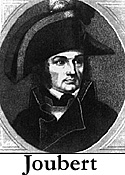 Joubert, Barthelemy: He was born the same year as Napoleon and was considered for the role as the "sword" needed for the overthrow of the Directory before his death at the battle of Novi on 15 August,1799. He combined courage with a quick tactical mind. He would fight in most of the major engagements of 1796-97 and be given the honor of returning with the captured trophies following the cessation of hostilities. Probably would have been a Marshal had he lived.
Joubert, Barthelemy: He was born the same year as Napoleon and was considered for the role as the "sword" needed for the overthrow of the Directory before his death at the battle of Novi on 15 August,1799. He combined courage with a quick tactical mind. He would fight in most of the major engagements of 1796-97 and be given the honor of returning with the captured trophies following the cessation of hostilities. Probably would have been a Marshal had he lived.
Kilmaine, Charles Edouard: This 45 year old veteran of the American Revolution would rise to command the Army's cavalry following the death of General Stengel. Although constantly ill, he built up the French cavalry until it was a match for any opponent. His chronic infirmity would eventually kill him in 1799.
Vaubois, Charles Henri: He had advanced through the first days of the Revolution as a commander of volunteers. At age 48, he started the 1796 campaign in the Army of the Alps under Kellerman. Transferred to the Army of Italy following Lodi, he commanded a division and played a crucial role at Arcola, where his men held off a much larger force allowing Napoleon to achieve the victory. This achievement was all the more remarkable because he commanded some of the worst troops in the army.
Napoleon's Austrian Opponents
Most of the Austrian commanders were much older than their French counterparts. Alvintzy, a spry 61 in 1796, would be defeated by Napoleon at Arcola and Rivoli. Beaulieu and Wurmser, who commanded major Austrian armies in Italy, were both over 70 when the campaign began! Long, loyal service had earned them the gratitude of the Hapsburg monarchy, but these men were unable to keep pace with what David Chandler summarized as: "...the end of an era. The days of limited eighteenth-century warfare were fast drawing to a close in the face of the energy and ideology of the French Revolutionary armies, now led for the first time by a general really worthy of their latent talents."
Alvintzy, Josef: This Transylvanian General had been the victor of the battle of Neerwinden in 1794. He commanded an attempted relief force for Mantua but was stopped at Arcola.
Argenteau, Eugene Guillaume-Alexis: He was a descendant of General Mercy, the Catholic commander at the battle of Nordlingen in the Thirty Years War. He also was the cousin of Marie Antoinette's chief councilor. He would distinguish himself in the Seven Years War as well as against the Turks before leading a column under Beaulieu.
Beaulieu, Johann Peter: Commander of the Austrian forces in Italy at the outset of 1796. A veteran of the Seven Years War, his plan for the defeat of the French showed promise against an average opponent. Napoleon defeated the 71 year old general repeatedly until Beaulieu was dismissed following his loss at Borghetto. Although scoring victories over several French generals, including Jourdan, Beaulieu was no match for the young Corsican.
Colli, Michael: Although an Austrian, Colli started 1796 in command of the Sardinian-Piedmontese Army. After their defeat and exit from the First Coalition, he took command of the Papal forces until the Treaty of Tolentino in 1797 which removed the Papacy from the First Coalition.
Davidovitch, Paul von: He served as second in command to both Wurmser and Alvintzy, leading independent columns. It was his troops that forced the temporary abandonment of the siege of Mantua. He would thereafter alternately guard and threaten the Adige River valley approach between the Tyrol and Verona.
Lipthay, Anton: An aggressive commander who had won the battle of Negutin against the Turks despite being outnumbered more than two to one. He made the night attack which resulted in Laharpe's death and fought the successful rearguard action after the defeat of Borghetto. He was wounded and knocked out of the campaign at Castiglione. Three years later he would be wounded again, this time mortally, at the defense of Verona.
Quasdanovitch, Peter: Commanded an independent column moving to the west of Lake Garda and would be defeated at Lonato by Massena. He went on to lead the ill-fated column crushed at Rivoli.
Sebettendorf, Charles Philippe: As a scion of a military family he commanded the Waldeck Infantry Regiment. In 1796 he commanded the rearguard at Lodi and led one wing of the final Austrian attempt to break out of Mantua at the end of the year.
Wukassuvich, Joseph Philipp: He was a colonel at the start of the campaign, and one of the few Austrian heroes at the battle of Loano the previous year. It was his well-executed counter attack at Dego that had almost derailed Napoleon's plans. He continued to rise through the ranks until killed at Wagram in 1809.
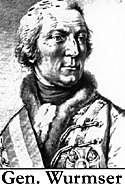 Wurmser, Dagobert Sigismond: This Alsatian had been in the Austrian service since 1747. He was a tough old hussar and brought a rough and ready attitude to battle. He had been the Army commander on the Upper Rhine and was successful until sent to try and retrieve the situation in Italy. While he was able to briefly relieve the siege of Mantua, his defeats at Castiglione and Bassano created the need to send another Austrian Army into Italy. Following Bassano he eluded the French and entered Mantua. Wurmser's army would whither away from disease in that pest hole. He was, however, under orders to hold Mantua until relieved.
Wurmser, Dagobert Sigismond: This Alsatian had been in the Austrian service since 1747. He was a tough old hussar and brought a rough and ready attitude to battle. He had been the Army commander on the Upper Rhine and was successful until sent to try and retrieve the situation in Italy. While he was able to briefly relieve the siege of Mantua, his defeats at Castiglione and Bassano created the need to send another Austrian Army into Italy. Following Bassano he eluded the French and entered Mantua. Wurmser's army would whither away from disease in that pest hole. He was, however, under orders to hold Mantua until relieved.
The 200th Anniversary Series on Napoleon in Italy
-
First Installment: Side Road To Immortality
Second installment: The Supporting Cast
Third installment: Maintaining the Initiative
Fourth installment: General Bonaparte Defends His Conquests
Fifth installment: Napoleon Turns Defeat into Victory
Sixth installment: One Final Victory: Rivoli
Seventh installment: Endgame: The Pursuit to Final Victory
Eighth installment: Instrument of Victory: Army of Italy
About the author:
Todd Fisher is the CEO of Emperor's Press and the Emperor's Headquarters. He is also the Executive Director of the Napoleonic Society of America. This is the second installment of an ongoing series begun in Napoleon #2 promoting the Napoleonic Era's bicentennial.
Back to Table of Contents -- Napoleon #3
© Copyright 1996 by Emperor's Press.
This article appears in MagWeb (Magazine Web) on the Internet World Wide Web.
The full text and graphics from other military history magazines and gaming magazines are available at http://www.magweb.com